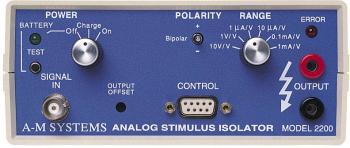Model 2200 Analog Stimulus Isolator
The Model 2200 Analog Stimulus Isolator provides signal scaling, conversion, and opto-electrical isolation. You can use rechargeable batteries for up to eight hours at a time.
- Overview
- Specifications
- Links
Key Features:
- Easy to Use: Common BNC Input Connector
- Long Battery Life: 8-Hour Running Time ±50 V at 5 mA
- Any Waveform Shape: Isolates and Scales Any Signal You Can Generate
For stimuli produced by your signal source, the Model 2200 Analog Stimulus Isolator offers opto-electrical isolation, signal scaling, and conversion to constant current or constant voltage. With a broad bandwidth, the output signal — which is DC-coupled — can have any waveform, including pulses.
With the Range switch set to scale the input signal voltage, the output can be as much as 100V (or ± 50V in bipolar mode) and ±5mA. A TTLlevel signal control gate can be used to turn on and off the output signal. An error indicator alerts the user to the problem if the instrument is unable to follow the input signal for any reason.
The battery-operated, optically linked, and isolated output segment offers superior isolation over the input part. Two rechargeable batteries are used: a 12V battery powers the signal, and a 9V battery powers the control electronics.
Both rechargeable batteries can run continuously for at least eight hours at full capacity. It is advised that the device be kept on a trickle charge by connecting it to an external battery charger while it is not in use. There is an internal battery tester available. It only takes an overnight charge cycle with the included charger to prepare the 2200 for use the following day.
The output capacity of a constant voltage or constant current can be increased by grouping two units together. Remote On/Off operation and remote battery condition detection are made possible by the digital control port.
You can also visit site of the manufacturer.


